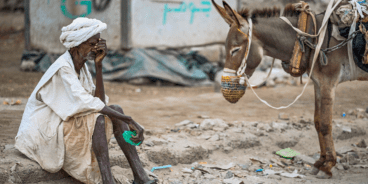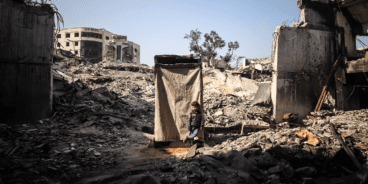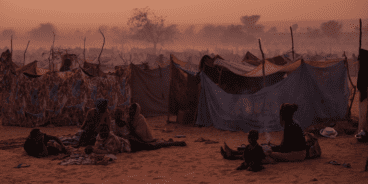
Defining the Four Mass Atrocity Crimes
During the 2005 United Nations World Summit, heads of state and government accepted the responsibility of every state to protect its population from four crimes: genocide, war crimes, crimes against humanity and ethnic cleansing.
The first three crimes are legally defined in various international legal documents, such as the 1948 Convention on the Prevention and Punishment of the Crime of Genocide, the 1949 Geneva Conventions and their 1977 Additional Protocols, and the 1998 Rome Statute of the International Criminal Court. Their status as international crimes is based on the belief that the acts associated with them affect the core dignity of human beings, both in times of peace and in times of war.
GENOCIDE
Genocide means acts committed with intent to destroy, in whole or in part, a national, ethnical, racial or religious group, including:
-
- Killing members of the group;
- Causing serious bodily or mental harm to members of the group;
- Deliberately inflicting on the group conditions of life calculated to bring about its physical destruction in whole or in part;
- Imposing measures intended to prevent births within the group;
- Forcibly transferring children of the group to another group.
To constitute genocide, there must be a proven intent on the part of perpetrators to physically destroy a national, ethnic, racial or religious group. Victims of this crime are deliberately – and not randomly – targeted because of their real or perceived membership in one of the four protected groups. Genocide can also be committed against only a part of the group, as long as that part is identifiable and “substantial.”
WAR CRIMES
There is no single document in international law that codifies all war crimes. Lists of war crimes can be found in both International Humanitarian Law (the Hague and Geneva Conventions) and International Criminal Law treaties (the Rome Statute of the International Criminal Court), as well as in international customary law. War crimes take place in the context of an armed conflict, either international or non-international. What constitutes a war crime may differ depending on whether an armed conflict is international or non-international.
The Rome Statute of the ICC makes a distinction between four categories of war crimes, depending on its character:
War crimes in international armed conflicts include:
-
- Grave breaches of the 1949 Geneva Conventions, such as:
o Willful killing, torture or inhuman treatment, or willfully causing great suffering or serious injury to body or health against the sick, wounded and shipwrecked persons not taking part in hostilities, prisoners of war and other detainees, civilians and civilian objects.
o Extensive destruction and appropriation of property, not justified by military necessity and carried out unlawfully and wantonly.
- Grave breaches of the 1949 Geneva Conventions, such as:
-
- Other serious violations of the laws and customs, such as:
o Intentionally directing attacks against the civilian population as such or against individual civilians not taking direct part in hostilities;
o Intentionally directing attacks against civilian objects, that is, objects which are not military objectives;
o Attacking or bombarding, by whatever means, towns, villages, dwellings or buildings which are undefended and which are not military objectives;
o Employing poison or poisoned weapons.
- Other serious violations of the laws and customs, such as:
War crimes in non-international armed conflicts include:
-
- Serious violations of Article 3 common to the 1949 Geneva Conventions, such as:
o Violence to life and person, in particular murder of all kinds, mutilation, cruel treatment and torture of persons taking no active part in the hostilities, including members of armed forces who have laid down their arms and those placed hors de combat by sickness, wounds, detention, or any other cause against the sick, wounded and shipwrecked persons not taking part in hostilities, prisoners of war and other detainees, civilians and civilian objects.
- Serious violations of Article 3 common to the 1949 Geneva Conventions, such as:
-
- Other serious violations of the laws and customs, such as:
o Intentionally directing attacks against the civilian population as such or against individual civilians not taking direct part in hostilities;
o Intentionally directing attacks against buildings dedicated to religion, education, art, science or charitable purposes, historic monuments, hospitals and places where the sick and wounded are collected, provided they are not military objectives.
- Other serious violations of the laws and customs, such as:
By contrast to genocide and crimes against humanity, war crimes can be committed against a diversity of victims, either combatants or non-combatants, depending upon the type of crime. In international armed conflicts, victims include wounded and sick members of armed forces in the field and at sea, prisoners of war and civilians. In the case of non-international armed conflicts, protection is afforded to persons taking no active part in the hostilities, including members of armed forces who have laid down their arms and those placed ‘hors de combat’ by sickness, wounds, or detention. In both types of conflicts protection is also afforded to medical and religious personnel, humanitarian workers and civil defense staff.
CRIMES AGAINST HUMANITY
Crimes against humanity have not yet been codified in a separate treaty of international law, unlike genocide and war crimes, although there are efforts to do so. The crime has, however, been clearly defined in the Rome Statute of the International Criminal Court.
The crime against humanity means acts committed as part of a widespread or systematic attack directed against any civilian population, such as:
-
- Murder;
- Extermination;
- Deportation or forcible transfer of population;
- Torture;
- Rape, sexual slavery, enforced prostitution, forced pregnancy, enforced sterilization, or any other form of sexual violence of comparable gravity;
- The crime of apartheid;
- Other inhumane acts of a similar character intentionally causing great suffering, or serious injury to body or to mental or physical health.
Crimes against humanity involve either large-scale violence in relation to the number of victims or its extension over a broad geographic area (widespread), or as part of a wider policy or plan (systematic). This excludes random, accidental or isolated acts of violence.
ETHNIC CLEANSING
Ethnic cleansing has not been recognized as an independent crime under international law. The term surfaced in the context of the 1990’s conflict in the former Yugoslavia and has been used in resolutions of the UN Security Council and the General Assembly. Notably, the term has been acknowledged in judgments and indictments of the International Criminal Tribunal for the Former Yugoslavia, although it did not constitute one of the counts for prosecution.
A UN Commission of Experts mandated to look into violations of international humanitarian law committed in the territory of the former Yugoslavia defined ethnic cleansing in its interim report as “rendering an area ethnically homogeneous by using force or intimidation to remove persons of given groups from the area” and as “a purposeful policy designed by one ethnic or religious group to remove by violent and terror-inspiring means the civilian population of another ethnic or religious group from certain geographic areas.”
The Commission also stated that coercive practices used to remove the civilian population can include: murder, torture, arbitrary arrest and detention, extrajudicial executions, rape and sexual assaults, severe physical injury to civilians, forcible removal, displacement and deportation of civilian population, deliberate military attacks or threats of attacks on civilians and civilian areas, use of civilians as human shields, destruction of property, and robbery of personal property, as well as attacks on hospitals, medical personnel, and locations with the Red Cross/Red Crescent emblem.
Related Publications


Atrocity Alert No. 440: Israel and the Occupied Palestinian Territory, Protection of Civilians and Libya
